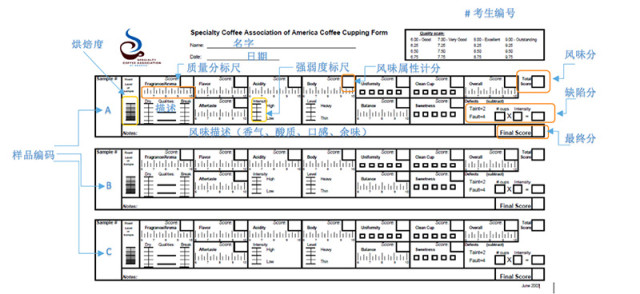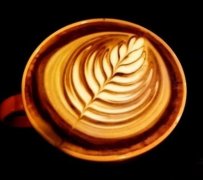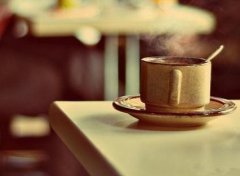SCAA (Specialty Coffee Association of America) Standard Coffee Cup Test
[Cup Test Environmental Equipment]

① Description of cups and bowls used for cup testing:
SCAA recommends tempered glass or porcelain cups with a capacity of 207-266ml and a diameter of 76-89 mm. The lid can be made of any material.
All utensils must be clean, odor-free, of the same specifications and materials (e.g., glasses and porcelain bowls cannot be mixed, and different capacities cannot be mixed)
[Preparation of cup test sample]
baking
1. Cup test sample needs to be baked within 8-24 hours before cup test
2. The baking degree of the cup test sample is
M-Basic Agtron Tester, Whole Bean 58(+/-1), Ground Powder 63(+/-1)
SCAA Baked Color Plate, Whole Bean #55, Ground Powder #60
3. Bake samples for 8-12 minutes, and there must be no baking defects such as bean body or bean end burns
4. After baking, the beans should be air-cooled, not water-cooled; after cooling to room temperature, they should be bagged and stored in a cool place away from light, sealed, but not refrigerated or frozen.
water-powder ratio
5.8.25g powder corresponds to 150ml water
6. First, measure the total water content of the cup/bowl, and then calculate the required amount of coffee powder according to the above ratio, and weigh the whole coffee beans with an error of +/-0.25g.
Cup Test Preparation
1. The cup test sample should be ground before the cup test is started; the principle is that if there is no cover, water must be injected within 15 minutes at most; if there is a cover, water injection cannot be started for more than 30 minutes.
2. The cup test sample should be weighed according to the whole bean to the above water powder ratio
3. Grindability requirements are: 70%-75% of ground coffee powder passes through American Standard #20 mesh sieve; before grinding each sample, clean the grinder with a small amount of the same sample beans to avoid cross-influence between samples. (Chongqing Brista Coffee West Point Training School)
water injection
1. Water quality requirements are: clean without odor, the best range of total mineral solubility TDS is 125-175ppm.
2. The water for cup test cannot be reheated, it should be fresh, and the water temperature when filling should be 200 degrees Fahrenheit or 93 degrees Celsius (adjusted according to different altitudes).
3. Fill the cup to the edge of the measuring cup/bowl when filling. The amount of water injected into each cup should be consistent. Soak all the coffee powder and let stand for 3-5 minutes.
[Sample cup test]
cup test purpose
Determine differences between samples
Describe the flavor of each sample
Product positioning reference
Introduction to Cup Test Form
1. The cup test table is a tool derived for evaluating samples numerically. SCAA's cupping table is divided into three sections
Sample baking degree identification
Flavor attribute identification and scoring
Defect Level, Quantity and Scoring
where you'll find
Two scales: horizontal (mass), vertical (intensity)
Scores: Individual scores range from 6 to 10 out of 10, with 0.25 points for each cell
5 squares correspond to 5 cups per sample
The flavor score minus the defect score is the final score for the sample
Each cup meter can record 3 samples
Below we compare the table to explain each item and its completion precautions:

1. First fill in the name, date and identify your candidate number in the upper right corner
2. Sample code: generally labeled in alphabetical order, such as A,B,C,D,E,F; fill in the number identification on the test table with reference to the cup
3. Roasting degree: vertical scale, only identify the depth of roasting degree, observe the color of coffee powder before smelling dry fragrance as identification
4. Quality Scale: Within each flavor attribute cell there is a horizontal scale that marks the quality score of that flavor attribute.
5. Strength Scale: In addition to the horizontal scale, there is also a vertical scale in the cells of aroma, acidity and taste attributes to mark the strength (aroma, acidity) or thickness (taste) of the attributes.
6. Description: There are two horizontal short-line spaces in the aroma cell, which are used to describe the dry aroma and wet aroma; there is a long blank area below all flavor attribute cells of each sample, which is used to record the flavor characteristics of the sample, describing it from the aspects of aroma, acidity, taste, aftertaste, etc.
7. TotalScore: Flavor score, which is the sum of individual scores for all flavor attributes.
Defect score: If one or more cups of the sample have an unpleasant bitter, sour taste or unpleasant aroma, record the defect score according to the grade and number of cups; slight grade (2 points/cup), severe grade (4 points/cup); if slight and severe grades occur simultaneously, all are calculated according to severe grade.
8. FinalScore: The final score is the flavor score minus the defect score.
[Description of Flavor Attributes and Defects]
1. Fragrance (Dry)/Aroma(Wet) Dry, Wet Aroma
First identify from the big categories, such as floral, fruity, nuts, woody dry distillation, etc., and then give scores according to the richness and strength of the aroma. Note that the aroma part is marked with a vertical scale of strength.
2. Acidity (acidity, acidity)
The acid rating is partly based on the stimulus coffee gives you (layering, sweet degree) to judge whether the acid is excellent or bad, the strength of the acid does not represent the quality of the acid; some coffee after the entrance has obvious acid stimulation, such as grapefruit, plum sour feeling, coffee swallow, tongue still have acid feeling stay on both sides, that this acid is very good; although some coffee does not have strong acidity, but coffee together acid feeling is very soft, like the sour and sweet feeling of mature fruit, but also very good acid;
3. Flavor Overall Flavor
Overall flavor perception, including aromas and flavors (considering complexity and layering)
4.Mouthfeel-Body Taste
Smoothness, consistency and thickness of coffee liquid; this part is felt by the oil insoluble in water in coffee liquid and the woody structure of coffee beans.(ground very fine particles) and protein composition; we can compare different coffee samples to feel the difference in taste thickness, daily life can try to compare different mineral water and pure water, skim milk, low-fat milk, whole milk, fruit juice with pulp particles, to feel the weight and smoothness of insoluble substances in different liquids.
5. Aftertaste
The taste sensation that stays in the mouth after swallowing, including aroma, taste and taste; it can be a creamy aftertaste, it can make a lasting sour feeling, it can be a smooth taste or even a dry taste.
6. Sweetness
Sweetness in the current table is scored on a 5-cup sample basis, with 5 cells representing 5 cups of coffee sample and 2 points for each cup. The standard of judgment is to see whether there is no sweet feeling in coffee, where the sweet feeling of coffee is judged by the sweet feeling of adding 15g sugar to 2l of water. Usually, if coffee is infected by foreign factors, chemical changes occur in coffee beans, such as moldy or internal organic acid changes will bring out excessive acid, bitter, and even chemical smell of potion, such coffee will be very uncomfortable, and even nausea to vomit, then we will give the sweet part to the cup or cups with problems. Chongqing Barista Coffee West Point Training School
7. Balance
Balance of aroma, taste and texture
8. Cleanup Cleanliness
Similar to sweetness, 5 cups are scored on a 2-point scale, and the score corresponding to the number of cups is deducted based on whether there is foreign contamination that causes unclean odors to appear.
9. Uniformity
Also according to 5 cups, 2 points for each cup; the purpose is to compare whether there is inconsistent flavor performance in multiple cups. If there is inconsistency in a certain cup or multiple cups, the score will be deducted according to the number of cups. The special explanation here is for consistency. We mainly find inconsistent bad flavor. If one cup in 5 cups tastes better than the other 4 cups, we will not deduct points.
10. Overall Personal preference for coffee only
11. Defect definition and scoring
The current SCAA cup test table defects are divided into two categories, mild grade (Taint) and serious grade (Fault), the difference between mild and serious is the degree of irritation to you, if the mouth is very uncomfortable, unable to swallow is calculated as a serious defect grade, if the discomfort is not so strong, then it is considered as a mild grade.
Mild grade: calculated by 2 points/cup
Severity: Calculated on a 4 point/cup basis.
In particular, examples of scoring for defects are as follows:
If two cups of coffee have an unpleasant taste, one mild and one severe, then the total defect score is calculated according to the severity level, that is, 2*4=8 total defect score of 8 points
12. Divided consideration of total score
This information comes from Q Mentors, not from SCAA official manuals
We divide coffee into four levels
Rare: Very outstanding quality, aroma, taste with strong recognition, this part of the production is very rare
Origin: outstanding quality, aroma, taste with recognition, the so-called recognition means that it is placed with other coffee, you can identify it
Specialty: Most of the fine coffee is in this position, the aroma and taste are good, but the flavor of the producing area is not very prominent, and the recognition is not enough.
Non-Specialty: Coffee green beans have obvious defects, which may be caused by inconsistent coffee maturity or improper processing and storage.
[Cup Test Flavor Identification Process]
1. Smell the dry aroma: lean over to smell the dry aroma of coffee powder, try not to touch the cup/bowl with your hands
2. Smell: After filling, lean over to smell the wet aroma on the surface of the wet coffee grounds
3. Slag breaking: After standing for 4 minutes after water injection, push the powder layer with a cup measuring spoon for 3 times to break the slag without excessive stirring.
4. Smell wet fragrance: After breaking the residue, most of the aroma substances will be released with hot water steam. At this time, the wet fragrance is the most intense. We use the wet aroma feeling at this time as the main evaluation basis for the wet fragrance part of the cup test.
5. Slag fishing: After a quick smell of wet incense, quickly carry out the slag fishing, remove the powder residue on the surface of the coffee liquid in the cup measuring bowl and cup, and reach the surface of most of the liquid surface clean.
6. taste
The first taste: cup measure spoon take a small amount of liquid, gently put into the mouth to feel the temperature of coffee liquid avoid direct sipping, temperature is too high burns. After the temperature is appropriate, take an appropriate amount of coffee liquid again, sip and taste, identify the flavor, aftertaste and record the coffee sample.
Second taste: the coffee temperature drops a little after the second sip, identify the coffee sample acidity, taste body and balance and record
Third taste: coffee liquid cooled to near room temperature, third sip, identify coffee sample uniformity, cleanliness and sweetness and record
Note that the order here is such a consideration because most of the aroma and flavor substances are easily volatilized when coffee is hot and captured by our mouth and nasal cavity, while the acidity, taste and balance of coffee liquid will change from hot to cold, so taste it at hot and mild room temperature to make a comprehensive judgment.
7. Record and calculate the total score
Scores of 80 or more are rated as specialty coffee.
Important Notice :
前街咖啡 FrontStreet Coffee has moved to new addredd:
FrontStreet Coffee Address: 315,Donghua East Road,GuangZhou
Tel:020 38364473
- Prev

Fine Coffee Science treats baristas correctly
Coffee is arguably one of the most valuable goods in the world. The world's three largest drinks, China is currently in a period of rapid development of coffee consumption, coffee sales increase by 20-30% every year, but do you know what the baristas feel? Customers sometimes misunderstand baristas. As baristas, we feel that the root of the problem lies in the understanding of coffee between customers and baristas.
- Next

Boutique Coffee Coffee Certification Organization of Coffee planting Industry
Fair Trade Coffee Fair Trade Coffee Fair Trade is one of the many coffee certifications and the most widely used international third-party certification. Certified coffee beans usually sell at a higher price. In Europe and the United States, the main circulation channels will set up special shelves of Fairtrade products for consumers to choose from. As the name implies, fair trade emphasizes the public.
Related
- Beginners will see the "Coffee pull flower" guide!
- What is the difference between ice blog purified milk and ordinary milk coffee?
- Why is the Philippines the largest producer of crops in Liberia?
- For coffee extraction, should the fine powder be retained?
- How does extracted espresso fill pressed powder? How much strength does it take to press the powder?
- How to make jasmine cold extract coffee? Is the jasmine + latte good?
- Will this little toy really make the coffee taste better? How does Lily Drip affect coffee extraction?
- Will the action of slapping the filter cup also affect coffee extraction?
- What's the difference between powder-to-water ratio and powder-to-liquid ratio?
- What is the Ethiopian local species? What does it have to do with Heirloom native species?

